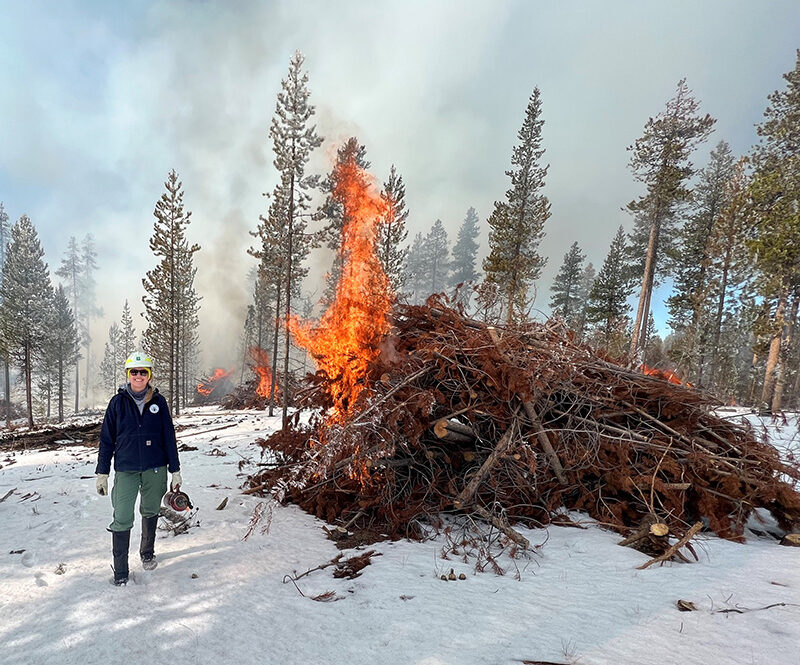Reporter for The Canyon Weekly
Michelle King has spent her entire professional career with the U.S. Forest Service. She started during her University of Washington undergraduate days as an intern in the Okanogan-Wenatchee National Forest.
After graduating from UW in 2011, King worked in a wide range of roles for the Forest Service, including National Environmental Policy Act issues, as a wildland firefighter, a public information officer and as a project planner at Spirit Lake near Mt. St. Helens.
A native of Huntington Beach, California, she has long-standing Pacific Northwest ties stemming from her mother’s background in the Verboort area of Washington County west of Portland.
In January, King became ranger of the Detroit District of the Willamette National Forest after prepping with a deputy ranger stint in the Deschutes National Forest and as acting ranger on the Sweet Home District of the Willamette.
King, 34, lives in Stayton with her partner John and their two dogs.
“Not surprisingly,” she said when asked what she likes to do in her free time, “I enjoy spending time outdoors. In the summer I try to get out for a hike or a long walk every weekend. I also enjoy cross-country skiing, mountain biking, and any adventure that can involve the dogs. John and I appreciate taking short and long road trips to explore new areas around the state and to visit our families.”
King, who is finishing her 11th month as the Detroit ranger, agreed to an email interview with The Canyon Weekly on her work as ranger and the challenges the Forest Service faces balancing fire recovery issues, environmental concerns and timber production.
The following email exchange was edited lightly for clarity and brevity:
TCW: What did you think your career path would be when you started at the University of Washington?
Answer: I was initially interested in environmental science and public service. At a UW career fair I learned about an internship with the Forest Service on the Okanogan-Wenatchee National Forest focusing on environmental policy and planning. During the two-year internship I was able to travel across the forest and gain an in-depth understanding of land management in the Pacific Northwest. I shifted my academic focus to forestry and natural resource management. When I graduated, I accepted a permanent job on the Naches Ranger District on the southern end of the Okanogan-Wenatchee NF, specializing in environmental policy and project planning.
TCW: When did you decide that becoming a district ranger was a goal of yours?
A: I explored different leadership opportunities for several years in various roles. When needed, I would fill-in and “act” for the ranger I was working for. I was always interested in learning about other program areas and appreciated having a seat at the table. In 2020 I started as the deputy district ranger on the Bend-Fort Rock Ranger District on the Deschutes National Forest. That management role solidified my interest in becoming a permanent district ranger when I found the right place at the right time. A few years later the ranger position opened in Detroit and now I am happily in my position on the Willamette National Forest.
TCW: Where do you see your career going in the next five to 10 years?
A: I would love to stay in Detroit for the foreseeable future. I am looking forward to putting down some roots and understanding the complex landscape I get to work in. Living in Western Oregon also allows us to be close to my extended family and John’s family. Honestly, I’m not thinking about next steps in my career right now.
TCW: How would you characterize your role/duties as the district ranger?
A: I would characterize my role as a public servant who is the local leader of an organization that is managing the land for this generation and future generations. I manage and work with an interdisciplinary staff that is committed to caring for the land and providing multiple uses of the National Forest. As a decision maker, I am always analyzing and considering environmental trade-offs as well as how our actions on Forest Service land can impact our neighbors and partners.
TCW: What are your key priorities and responsibilities?
A: The top priority for the district is fire recovery, restoring the landscape, mitigating hazards, and re-opening the forest to the public. In my first year in the job, I am also focusing on strengthening internal and external relationships. We have a remarkable and dedicated staff in Detroit. It is a priority for me to support them as they accomplish the mission-critical work on the ground.
TCW: How has/is Forest Service work changing amid climate threats and issues related to wildfires?
A: The Forest Service has a robust program focused on studying and adapting to climate change. There is quality information regarding the agency’s overall approach here: https://www.fs.usda.gov/science-technology/climate-change.
TCW: How have those changes affected your work in Detroit?
A: We are constantly analyzing the environmental conditions to make climate-informed management decisions. We utilize the best available science and local expertise to analyze how our actions may both be impacted by and could contribute to climate change. At the district-level, I approach this topic on a project-by -project basis. It is one of many factors we have to consider when proposing new vegetation management projects, designing planting programs, fighting wildfires, planning restoration projects, etc.
TCW: In the post-2020 wildfires environment there are a wide range of opinions about how to manage the Willamette National Forest in a way that preserves the resource while also protecting it from fires. Thoughts on the best way to achieve these two goals?
A: The Willamette National Forest is constantly evaluating our land management strategy when it comes to vegetation management, prescribed fire, and wildfire management. In the last five years, nearly 25 percent of the Willamette NF land base has experienced wildfire. We are working on a forest-wide integrated vegetation management strategy that meets our landscape objectives and is consistent with current laws, regulations, and Forest Service policy. Individual units will continue to complete projects at the district scale, but this assessment will allow us to take a snapshot of where we have been and provide alignment as we move forward.
In Detroit, we will continue to prioritize landscape recovery work. We are in the planning process for future vegetation management projects and fuels reduction projects. To supplement local capacity, we are partnering with the Oregon Department of Forestry through the Good Neighbor Authority to receive support in project planning and implementation.
TCW: What have you learned about the Santiam Canyon during your first year on the job?
A: So much! On a human level I am constantly learning about the resilience of the community and our employees. What people went through in 2020 is unimaginable. However, day after day folks show up to restore, rebuild, and support each other. Recovery can be slow and frustrating at times. I am humbled by the perseverance and dedication to the area people in the Canyon have.
TCW: Is there a little-used recreational gem in the Detroit District you think outdoor enthusiasts should explore? What are some of your favorite spots?
A: I have really enjoyed exploring the Mt. Jefferson Wilderness. I was able to complete four different day hikes and one horseback ride this summer in the Mt. Jeff. There is a huge variety across the wilderness, including burned and unburned landscapes. If I had to choose, hiking out to Marion Lake was my favorite day this year. I still feel relatively “new” to really know all the gems we have. An area that I am excited to explore more within the Willamette NF is along the border of the Detroit Ranger District and the Sweet Home Ranger District. The Forest Service Road 11 (also known as the Quartzville Back Country Byway) is a great place to go for a long windy drive through the woods. There are also several non-wilderness trails in this area that provide a sense of remoteness and exploration.
TCW: Anything else that you think I need to know?
A: Thank you for the opportunity to talk about the Forest Service and the Detroit Ranger District. I would add that our front desk is open and we love having visitors. Christmas tree permits are now available and the Willamette NF is participating in the annual Willamette Valley Ornament Hunt. The Forest Service is also in the main hiring period for the 2024 seasonal workforce. If people are interested in working for the Forest Service you can call or visit our front desk, visit the Willamette NF website, or the Willamette NF Facebook page for more information.





